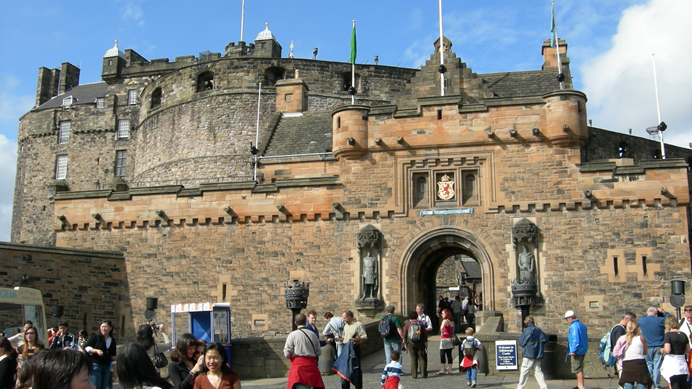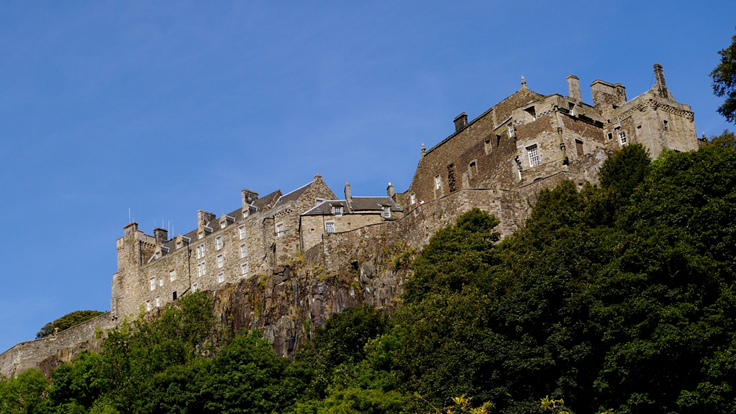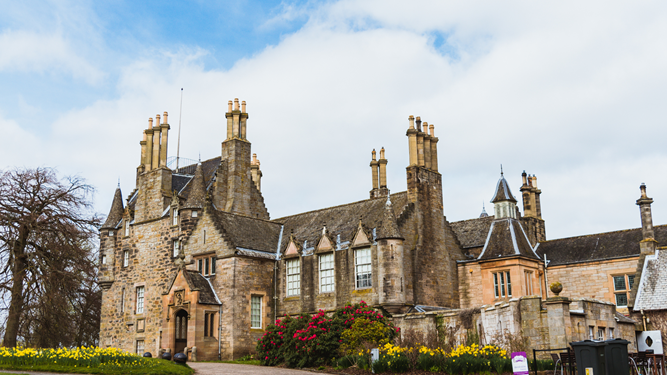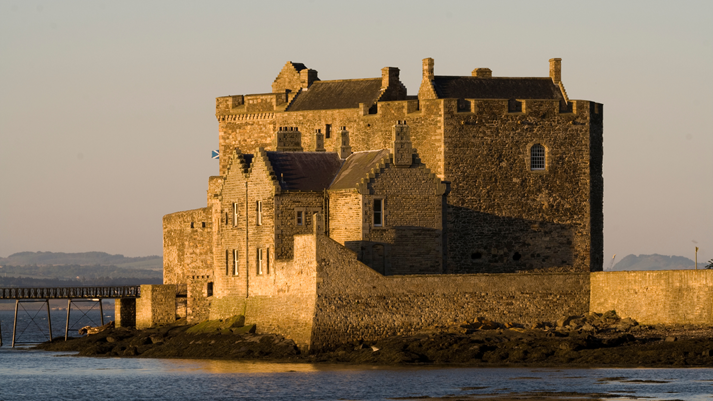Castles Near Edinburgh
January 31, 2024
Step into the captivating history of Scotland’s capital as we explore iconic castles near Edinburgh. From ancient fortresses that have stood the test of time to secluded grand estates gracing the city's outskirts, Edinburgh's castles unveil tales of royalty, conflicts, and architectural wonders.
Join us in unravelling the stories and history of these formidable structures, immersing ourselves in the elegant beauty that defines Edinburgh's castle landscape. Let us be your guide to the castles near Edinburgh, including insights into their histories, how to reach them, and the enchanting experiences that await your discovery.
While you enjoy uncovering castles near Edinburgh, why not enjoy a stay with us and revel in our gothic glamour and iconic dining rooms, right at the foot of the first castle on our list: Edinburgh Castle.
Edinburgh Castle
History and Significance
Perched dramatically on Castle Rock, Edinburgh Castle is one of Scotland's most iconic landmarks and has become a symbol of the nation's history. The site of Edinburgh Castle has a history dating back to at least the Iron Age and archaeological evidence suggests human occupation of Castle Rock from as early as the 2nd millennium BC. The castle itself is built on top of an inactive volcano and dominates the landscape of Old Town.
The castle's rich and storied history traces its origins back to the 12th century, a period when King David I, a key figure in medieval Scottish history, erected a royal castle atop the formidable Castle Rock. This strategic location provided not only a commanding view of the surrounding landscape but also served as a symbol of royal authority and power.
Over the years, the castle witnessed significant historical events, serving as a witness to political intrigues, royal ceremonies, and battles that shaped the destiny of the kingdom. Its halls echoed with the footsteps of monarchs, courtiers, and soldiers, each contributing to the legacy of this venerable stronghold.
The castle's role expanded beyond its military function, becoming a centre of political administration, cultural patronage, and royal residence. Grand halls were built for state ceremonies, while chambers housed royal households and their retinues. The castle became a focal point for the arts, literature, and diplomacy, showcasing the multifaceted nature of its significance in the broader context of medieval society.
As the centuries unfolded, the castle not only survived the ravages of time but also bore witness to changes in architectural styles and cultural preferences. Its structures evolved from medieval fortifications to more aesthetically pleasing and functional residences, reflecting the changing nature of governance and societal norms.
In essence, the recorded history of the castle on Castle Rock is a captivating saga of resilience, adaptation, and the enduring legacy of the medieval monarchy. Its walls have not only withstood the test of time but have also stood as silent witnesses to the ebb and flow of history, embodying the spirit of a bygone era.
Today the castle still stands proud and hosts several exciting events throughout the year such as the famous Edinburgh Tattoo. Taking place in August as part of the broader Edinburgh Fringe Festival, it has become one of the most iconic and popular events in Scotland, drawing visitors from different parts of the world who come to witness the unique blend of military tradition, music, and entertainment against the backdrop of Edinburgh Castle.
What Visitors Can Expect at Edinburgh Castle
Discover the treasures within Edinburgh Castle, including the Crown Jewels displayed in the Crown Room, the medieval Great Hall, and the oldest surviving building in Edinburgh—St. Margaret's Chapel. Gain poignant insights into Scotland's military history at the National War Museum and Scottish National War Memorial.
The regimental museums, such as The Royal Scots Regimental Museum and the Royal Scots Dragoon Guards Museum, provide a detailed narrative of Scotland's military heritage.
Enhance your castle experience by attending guided tours. Engage with knowledgeable guides who bring the history and legends of the castle to life. Visitors can also enjoy a bite to eat on their day of exploring with an elegant tea room and the Redcoat Café. Guests can also witness the world-known One O’Clock Gun.
Since 1861, Edinburgh's One o'Clock Gun has marked time for ships in the Firth of Forth, originally a 64-pounder and now a 105mm field gun fired from Mills Mount Battery. Crowds gather daily at 1 pm, excluding Sundays, Good Friday, and Christmas Day, to witness the historic spectacle. Positioned near the Redcoat Café and the Portcullis Gate, the cannon's unexpected boom surprises those on Princes Street below. This enduring maritime tradition, brought to Edinburgh by businessman John Hewat from Paris, serves as a daily reminder of the city's rich seafaring heritage. Don't miss the chance to experience the convergence of history and modernity in the resounding echo of the One o'Clock Gun.
How to Get to Edinburgh Castle
Edinburgh Castle is easily reached on foot from the city centre or through public transportation, such as buses and trams will get you to Princes Street - the castle is a short walk from there, though can be challenging due to steep hills. Parking is available for those driving, but limited. Taxis, ride-sharing services, and tourist buses provide convenient drop-off options. Guided tours with transportation are also available, and Waverley Railway Station is close by for those arriving by train.
Ensure to check for transportation changes, especially during events, and follow the signs guiding visitors to the iconic Edinburgh Castle.

Stirling Castle
History and Significance
Stirling Castle, a historic fortress perched on Castle Hill in the city of Stirling, has a rich history dating back to the early 12th century. Its strategic location played a pivotal role in significant conflicts, including the Wars of Scottish Independence. The castle's architecture reflects a blend of Renaissance and Gothic styles, featuring notable structures like the Royal Palace, the Great Hall, the Chapel Royal, and the King's Old Building.
Commanding panoramic views from its volcanic crag, Stirling Castle served as a crucial stronghold for controlling access to central Scotland. The Great Hall, a splendid example of medieval architecture, hosted royal banquets and events. The Chapel Royal, built during James VI's reign, boasts intricate stained glass and a stunning oak hammer beam ceiling. The castle also houses the National War Museum of Scotland, showcasing military artefacts for those interested in Scotland’s rich history.
What Visitors Can Expect at Stirling Castle
Visitors to Stirling Castle have the opportunity to immerse themselves in a wealth of historical and cultural attractions.
Throughout the year, Stirling Castle hosts special events and festivals, including historical reenactments, concerts, and family-friendly activities, offering dynamic and immersive experiences for visitors.
Additionally, Stirling Castle offers educational programs for schools and families, providing engaging and interactive experiences to enhance understanding of Scotland's rich history. To complete the visit, guests can indulge in local cuisine at the castle's cafe and explore the gift shop for Scottish-themed souvenirs, books, and merchandise. With its rich history, architectural beauty, and cultural significance, Stirling Castle stands as a captivating destination that offers a multifaceted and enriching experience for all.
How To Get To Stirling Castle
Stirling Castle is easily accessible by various transportation options. Stirling Train Station, within walking distance of the city centre, connects the city to major locations, while Stirling Bus Station offers convenient bus services. The city's central location makes it accessible by car, with parking facilities available near the castle.
For those seeking guided tours, operators often include transportation to Stirling Castle. Walking or cycling from the city centre is also feasible, and taxi or ride-sharing services can drop visitors near the castle entrance. Clear signposts guide arrivals to the prominent Castle Hill location. Before planning your visit, check for transportation updates, especially during events.

Lauriston Castle
History and Significance
Lauriston Castle, a historic mansion on the western outskirts of Edinburgh, holds a legacy dating back to the 16th century. Originally built by Sir Archibald Napier, the castle underwent various modifications over time, showcasing a blend of Tudor and Jacobean architectural styles. Notable features include towers, turrets, and a charming walled garden, contributing to its historical charm.
Having changed hands multiple times, Lauriston Castle was owned by William Thomas Beckford in the 19th century and later became the residence of Sir Alfred and Lady Usher in the early 20th century. Following their bequest, the City of Edinburgh Council now owns the castle, which is open to the public.
What Guests Can Expect at Lauriston Gardens
Surrounded by picturesque gardens overlooking the Firth of Forth, Lauriston Castle offers visitors a serene escape into Edinburgh's past. The well-maintained grounds feature terraced lawns, flower beds, and pathways. Inside the castle, visitors can explore rooms that have been preserved to reflect the early 20th-century style, showcasing period furnishings, artwork, and historical artefacts.
Throughout the year, Lauriston Castle hosts various events and activities, including guided tours, workshops, and cultural programs. Its scenic location also makes it a sought-after venue for weddings and private events.
Before planning a visit, it's advisable to check the official website or contact Lauriston Castle directly for the latest information on opening hours, guided tours, and any special events.
How To Get To Lauriston Castle
Lauriston Castle is easily accessible by various means of transportation. The castle can be reached by bus, with several routes serving the area. For those driving, Lauriston Castle is conveniently reachable by car at the address Cramond Road South, Edinburgh, EH4 6AD.
Edinburgh's bike-friendly environment makes cycling to Lauriston Castle a viable option, and there are bike racks available near the castle entrance. If you're in the nearby neighbourhoods, walking to the castle is a pleasant option, allowing you to enjoy the picturesque surroundings.
Taxis and ride-sharing services are readily available in Edinburgh and can drop visitors off near Lauriston Castle. Simply inform the driver of your destination, and you'll be conveniently transported to the castle.

Other Castles Near Edinburgh
These castles and historic sites near Edinburgh offer a diverse range of experiences, from exploring medieval fortresses and royal residences to enjoying scenic landscapes and gardens steeped in history.
Linlithgow Palace
Linlithgow Palace, situated beside Linlithgow Loch, was a favourite residence of the Stuart monarchs. The palace showcases impressive courtyard architecture, a beautiful fountain, and a scenic location by the water. Visitors can explore the royal apartments and enjoy the picturesque surroundings.
Blackness Castle
Blackness Castle, on the Firth of Forth, stands as a formidable fortress with a unique ship-like appearance. Built in the 15th century, it served various roles, including as a royal residence and prison. The castle offers stunning views of the surrounding landscape and the Forth bridges.
Craigmillar Castle
Located on the outskirts of Edinburgh, Craigmillar Castle is a well-preserved medieval fortress. Known for its association with Mary, Queen of Scots, the castle features a courtyard, a great hall, and picturesque gardens. Visitors can explore the castle's chambers and towers.
Tantallon Castle
Tantallon Castle, perched on the East Lothian coast, provides breathtaking views of the North Sea. The fortress, dating back to the 14th century, played a role in various conflicts. Its dramatic cliff-top setting and well-preserved ruins make it a captivating destination for history enthusiasts.
Dirleton Castle
Nestled near North Berwick, Dirleton Castle is a medieval fortress surrounded by beautiful gardens. The castle's architecture includes a striking 13th-century keep and a Victorian mansion. The gardens feature a herbaceous border and a wildlife-friendly design.
Midhope Castle (Lallybroch)
Familiar to fans of "Outlander" as Lallybroch, Midhope Castle is a 16th-century tower house on the Hopetoun Estate. While not regularly open to the public, the castle's exterior attracts fans of the popular TV series.

Experience The Witchery in Edinburgh
At The Witchery by the Castle, we have some history of our own dating back to the 16th century. Situated in a collection of historic buildings on the Royal Mile, our unique venue has witnessed centuries of stories, from the tumultuous times of the Scottish Reformation to its transformation into the luxurious and iconic establishment it is today.
Indulge in a truly magical experience when you dine or stay with us. Whether you're seeking an unforgettable stay in one of our historic suites or a sumptuous dining experience in our renowned dining rooms, let the centuries of history enchant and captivate you. Book your stay or reserve a table now and immerse yourself in the allure of Edinburgh's most enchanting establishment.




